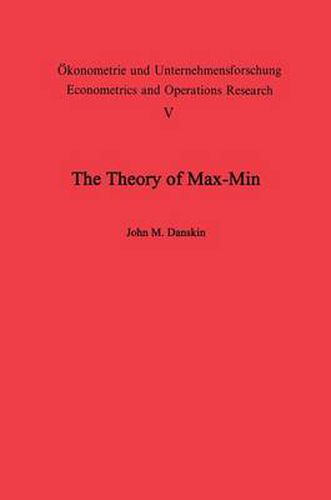Readings Newsletter
Become a Readings Member to make your shopping experience even easier.
Sign in or sign up for free!
You’re not far away from qualifying for FREE standard shipping within Australia
You’ve qualified for FREE standard shipping within Australia
The cart is loading…






This title is printed to order. This book may have been self-published. If so, we cannot guarantee the quality of the content. In the main most books will have gone through the editing process however some may not. We therefore suggest that you be aware of this before ordering this book. If in doubt check either the author or publisher’s details as we are unable to accept any returns unless they are faulty. Please contact us if you have any questions.
Max-Min problems are two-step allocation problems in which one side must make his move knowing that the other side will then learn what the move is and optimally counter. They are fundamental in parti cular to military weapons-selection problems involving large systems such as Minuteman or Polaris, where the systems in the mix are so large that they cannot be concealed from an opponent. One must then expect the opponent to determine on an optlmal mixture of, in the case men tioned above, anti-Minuteman and anti-submarine effort. The author’s first introduction to a problem of Max-Min type occurred at The RAND Corporation about 1951. One side allocates anti-missile defenses to various cities. The other side observes this allocation and then allocates missiles to those cities. If F(x, y) denotes the total residual value of the cities after the attack, with x denoting the defender’s strategy and y the attacker’s, the problem is then to find Max MinF(x, y) = Max [MinF(x, y)] .
$9.00 standard shipping within Australia
FREE standard shipping within Australia for orders over $100.00
Express & International shipping calculated at checkout
This title is printed to order. This book may have been self-published. If so, we cannot guarantee the quality of the content. In the main most books will have gone through the editing process however some may not. We therefore suggest that you be aware of this before ordering this book. If in doubt check either the author or publisher’s details as we are unable to accept any returns unless they are faulty. Please contact us if you have any questions.
Max-Min problems are two-step allocation problems in which one side must make his move knowing that the other side will then learn what the move is and optimally counter. They are fundamental in parti cular to military weapons-selection problems involving large systems such as Minuteman or Polaris, where the systems in the mix are so large that they cannot be concealed from an opponent. One must then expect the opponent to determine on an optlmal mixture of, in the case men tioned above, anti-Minuteman and anti-submarine effort. The author’s first introduction to a problem of Max-Min type occurred at The RAND Corporation about 1951. One side allocates anti-missile defenses to various cities. The other side observes this allocation and then allocates missiles to those cities. If F(x, y) denotes the total residual value of the cities after the attack, with x denoting the defender’s strategy and y the attacker’s, the problem is then to find Max MinF(x, y) = Max [MinF(x, y)] .